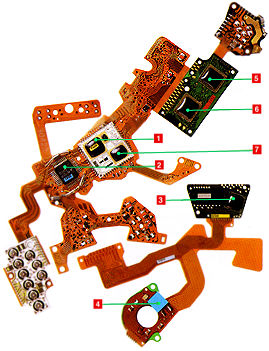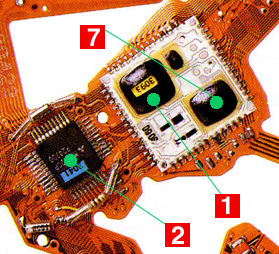The Flow Chart of how AMP Matrix Metering works. |
Circuit Operation Outlined
The basic circuit formation of the FA is similar to that of the FG, but the introduction of the automatic multi-pattern metering (MAP) has added some features including A/D converter, or microcomputer unit (MCU) as the digital data processing devices.
1. Exposure data input block
(a) Metering data input. This block is devided into the automatic multi-pattern metering (AMP) and aperture/shutter-speed control. For the AMP, it is necessary to input the five brightness analog values from the SPDs into the MCU with the help of D/A converter and the five comparators. For aperture/shutter-speed control, only the brightness value of center area is utilized.
(b) Other data input. The following exposure data of digital, amount as the gray code are inputted into the MCU via the input selector.
Mode selected: 2-bit
Lens speed in use: 4-bit
Aperture selected: 2-bit
Focal length signal: 2-bit
EE lens signal: 1-bit
Film speed: 5-bit
Stop-down lever: 1-bit
Shutter dial: 4-bit
Turning exposure compensation swi tch on makes exposure compensation LED light up and the compensated film speed is inputted into the MCU.
2. Digital data Processing
The exposure data are processed in tile MCU with the control the clock of ceramic oscillator 524 Khz (= 219).
- a) Correct exposure value. Correct exposure value is obtained for the' AMP for the center-weighted metering as BV0;
- b) LCD readout. LCD readout value is processed for the different mode select and outputted at terminals 00 - 07 to drive LCD panel.
3) D/A conversion
Correct exposure value of digital
is converted into a value analog in the D/A converter and utilized for shutter speed
aperture opening control.
a) While metering
The correct exposure value
(BV) is being compared with the brightness value (AV0) on a real-time basis. The
MCU verifies and determines the correct exposure value (BV-AV0) to be equal to the
real brightness value.
b) After shutter release
On P and S modes, the aperture
control value determined by the MCU is converted into an analog value.
c) After mirror rising
On A, S and P modes, the shutter
speed control value determined by the MCU is converted into an analog value. The
TTL flash control value is-provided when ready-light lights up. Aperture and shutter
speed control depends on the central brightness value, but also takes account of
off-center brightness values by shifting the film speed value.
| To realize Automatic Multi Pattern
Metering (AMP) and accurately control the FA's complex functions, Nikon has developed
one microcomputer and five IC chips to be used on the Nikon FA. Most of the ICs are
protected with an coating of silicone from moisture and dust penetration. Technomodes/Aperture Controller (1): Commands digital switching system to properly execute mulV-mode auto-exposure operation; also assures precise aperture control. TTL Metering Amplifier/Shutter Speed Controller (2): BiMOS IC with five head amplifiers used for five-segment AMP sensors and one for TTL flash metering sensor; also controls stepless shutter speeds and TTL flash output control. Decoder Driver (3): Recalls encoded display data and sends it to the digital LCD readout in c/ear, digital form. Ceramic Oscillator (4): This 524.288kHz oscillator has the same capacity as those used in personal computers and other high-technology equipment. All shutter speeds used (Except in Shutter Priority AE, B and M250) was governed by the accuracy of the oscillator. |
 |
Digital IC (5):
Digitally controls 13 shutter speeds from 1/4000 sec. to 1 sec. in the Manual mode,
complex and exacting operation timing for flawless execution in all modes, TTL flash
sync speed, 16-sec. meter ON timer, as well as functions as a multiplexer to input
lens data.

Microcomputer (6):
The FA's main command centre that does all computations for auto-exposure modes and
flash sync speed; it also gives computations for metering and digital displays as
well as controls the five IC chips with a 524.288kHz high-speed computation process.
D/A Converter (7):
Micro-computer controls 6-bit D/A converter to realize high-speed analog-to-digital
conversion of the five segments' brightness values by high-speed sequential comparison
method; D/A converter controlled by the microcomputer.
|
|
Software changes in Micro-computer happened once in 1984 |
Camera Instruction Manual
- HTML | PDF
(1.4 MB)
Main Reference
Map for Body -
HTML | PDF
(731k)
Specifications - HTML
| PDF (245k)
The AI-S Nikkors (related info | TTL OTF Flash Metering | Interchangeable Focusing Screens. The MD-15/MD12/MD11 Motor Drives | 3rd party Power Winder (new) | Flash Units -SB-16 | SB-15 | SB-10 | SB-16B & Other Options | Databacks | Titanium Shutter | Variation : Mr Y K Wong from Singapore contributing 11 images of his Nikon FA GOLD
| Nikon FM series |
Nikon FE series |
Nikon
FA |
W A R N I N G: The New G-SERIES Nikkor lenses have no aperture ring on the lens, they CANNOT ADJUST APERTURES with any of these manual focus Nikon FE series SLR camera models; please ignore some portion of the content contained herein this site where it relates.
| Nikkor Resources |
| Message Board | for
your favourite
Nikon
FA camera
| Message Board |
for your Nikon Optics in a shared environment
| Message Board |
Specifically for Dispose or Looking for Nikon / Nikkor Photographic Equipment
Home - Photography in Malaysia |
![]()
A contributing effort to Michael Liu's Classic Nikon SLR camera site.
Credit:
Lars Holst Hansen who
is co-maintaning the site; MClau, who patched a lot of mistakes for me on earlier
stage of the site; Miss Rissa Chan - Marketing
Manager and the members of technical service team of Shriro Malaysia (now Nkon Corporation
Malaysia); Mr Terence
HM Tan
for his FA/MD15 images; Mr Victor for his Nikon FA body, EEwyn, my nephew for some
of the scanning work; Mis Wati/Mis Mirza for their help on the OCR work on the instruction
manual section - We all had some real good times on the construction of this site.
Dave
Hoyt
who prepared the introductory page. Note:certain
content and images appeared in this site were either scanned from official marketing
leaflets, brochures published by Nikon and/or contribution from surfers who claimed
originality of their own work to publish in this site based on educational merits.
The creator of this site will not be responsible for any discrepancies that may arise
from such possible dispute except rectifying them after verification."Nikon", "Nikkormat", "Nippon Kokagu
KK"
& "Nikkor" are registered
tradename of Nikon Corporation Inc., Japan. Made with an Apple IMac.Dedicated to a friend: 'JB' whom
I have never met but remains a constant motivated force.

